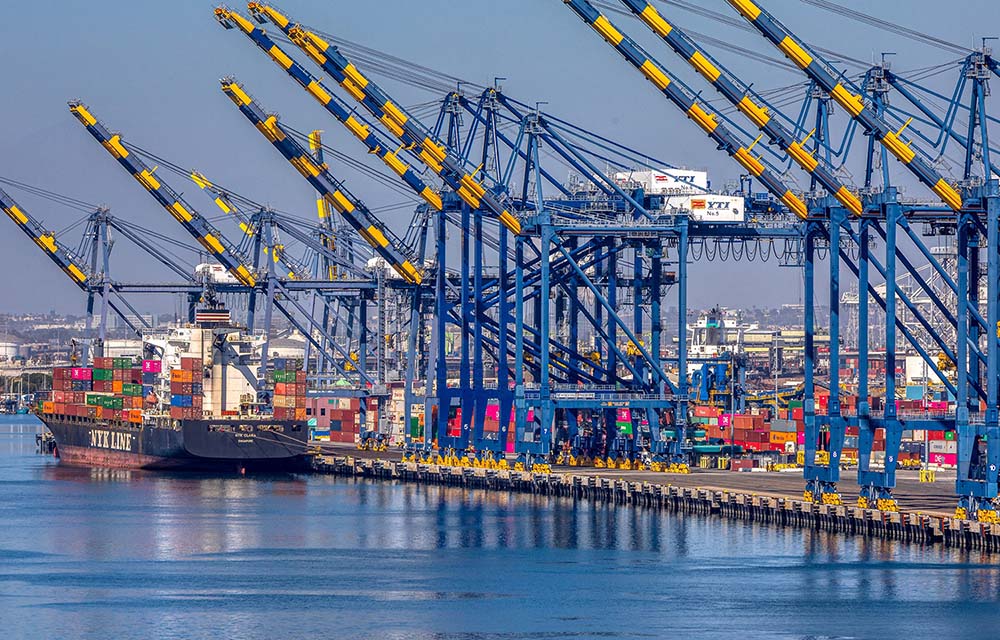A likely dockworker strike in the U.S., ongoing Houthi militia attacks in the Red Sea, and the upcoming U.S. presidential election, among other factors, caused shipping prices to rise and importers to rush cargo into U.S. ports this summer.
The U.S. presidential election in particular has the shipping industry bracing for change, according to Container XChange CEO Christian Roeloffs.
“[The] logistics industry [is] preparing for potential swings in container volumes, which will require more flexible supply chain strategies,” Roeloffs said in a release.
With that change on the horizon, Los Angeles and Long Beach, California – the two busiest U.S. ports – have seen container imports rise significantly this summer.
The Port of Los Angeles reported a 37 percent year-over-year increase in 20-foot equivalent unit (TEU) imports in July, a number which placed the port 18 percent ahead of its overall import rate at the same time the previous year.
The Port of Long Beach also saw growth, reporting that July 2024 was the third-busiest month in the port’s 113-year history, as well as its busiest July on record. Long Beach realized a 52.6 percent year-over-year increase in TEU imports.
Both ports attributed the increases to a surge in back-to-school and holiday goods driven by potential tariff increases that would come as the result of the upcoming election and Red Sea cargo diversions.
The continued blockade of the Red Sea by Iran-backed Yemeni Houthi rebels has particularly caused shipping distress and upended the global supply chain since the attacks began in October 2023. In response to the blockade, many major companies have sent their Asia-Europe cargo on costlier and longer routes around Africa to avoid the region. The Cape of Good Hope route has seen a subsequent 70 percent increase in use.
As the International Monetary Fund (IMF) has pointed out, this disruption is costliest for small companies with limited inventories, which can’t absorb increased delivery times alternate routes require or take bets on importing cargo they may not be able to sell.
Those smaller companies also have struggled with price increases attributed to the blockade, including significant year-over-year price increases for container leasing on China-Europe routes, which the American Journal of Transportation reports have climbed more than USD 1,000 (EUR 907) a month between July 2023 and July 2024.
The IMF also reported that Suez Canal traffic has been cut in half by the Red Sea crisis, with only 40 vessels a day passing through, causing losses totaling around USD 2 billion (EUR 1.8 billion) in revenue.
Though container prices in China stabilized in July, thanks to increased supply, container lease rates from China to the U.S. surged, with up to a 34 percent increase in costs between June and July for some routes this year.
“[A] natural reaction of supply chain managers in the face of potential further disruption, even though the rates are higher, has been to advance shipping times,” S&P Global Market Intelligence Director of Transportation Consulting Paul Bingham said, according to the Wall Street Journal.
With supply chain managers across the globe attempting to speed up shipping times, fierce competition between importers for space on container ships has arisen, filling U.S. warehouses to levels not seen since the height of the Covid-19 pandemic.
Besides Red Sea disruptions, the threat of U.S. East Coast and Gulf Coast dockworker strikes is also affecting costs, with container leasing rates from China higher to the West Coast of the U.S. than to the East Coast as importers have begun strategizing to avoid ports which may be affected by a strike.
The current contract of the International Longshoremen’s Association (ILA) expires on 30 September, and negotiations have stalled. The union, which represents some 80,000 workers across 36 East Coast and Gulf Coast ports, has a record of successfully pushing for some of the highest pay in the industrial workforce and has long been wary of automation’s potential to kill jobs. This issue is reportedly a sticking point in the current negotiations between the ILA and the US Maritime Association, which represents dockworker employers.
According to Consumer Reports, if no contract is reached by the end of the month, the union said a strike will close at least 12 U.S. ports.
“Retailers are concerned by the possibility of a strike at ports on the East and Gulf coasts because contract talks have stalled. Many retailers have taken precautions including earlier shipping and shifting cargo to West Coast ports,” National Retail Federation Vice President Johanthon Gold said in a press release.
After ILA meetings in early September, President Harold Dagget said that the union remained far apart from employers and that members must be prepared to strike on 1 October if a deal is not reached.
One bright spot for global shippers is rising water levels in Lake Gatun, which feeds the Panama Canal. This is encouraging news for Panama Canal transit, which has been curtailed by low water levels since 2023. When water in the canal is low, fewer vessels pass through each day, and the size limit of the vessels is reduced.
Elsewhere in the industry, India Shipping News reported the Adani Group will spend INR 200 billion (USD 2.4 billion, EUR 2.2 billion) on developing the Vizhinjam International Seaport in Kerala into India’s first international transhipment hub, decreasing the country’s dependence on ports in Singapore, Sri Lanka, and the United Arab Emirates.
Set to be complete over the next four years, the proposed improvements include a cruise terminal, a site for ship refueling, a fishing harbor, a cement grinding plant, and, reportedly, a “seafood park.” The INR 200 billion sum doubles Adnani’s initial investment in the port, and builds on the INR 88.6 billion (USD 1.1 billion, EUR 960 million) that has already been spent on the project, including INR 56 billion (USD 667 million, EUR 605 million) provided by the Kerala government.








